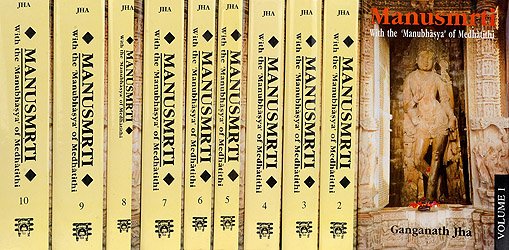Manusmriti with the Commentary of Medhatithi
by Ganganatha Jha | 1920 | 1,381,940 words | ISBN-10: 8120811550 | ISBN-13: 9788120811553
This is the English translation of the Manusmriti, which is a collection of Sanskrit verses dealing with ‘Dharma’, a collective name for human purpose, their duties and the law. Various topics will be dealt with, but this volume of the series includes 12 discourses (adhyaya). The commentary on this text by Medhatithi elaborately explains various t...
Verse 8.237
Sanskrit text, Unicode transliteration and English translation by Ganganath Jha:
धनुःशतं परीहारो ग्रामस्य स्यात् समन्ततः ।
शम्यापातास्त्रयो वाऽपि त्रिगुणो नगरस्य तु ॥ २३७ ॥dhanuḥśataṃ parīhāro grāmasya syāt samantataḥ |
śamyāpātāstrayo vā'pi triguṇo nagarasya tu || 237 ||Around the village there should be a pasture-ground, four hundred ‘bows’ or three ‘stick-throws’ (in width); but three times that space around the town.—(237)
Medhātithi’s commentary (manubhāṣya):
the ‘bow’ is four cubits in length; four hundred such ‘bows.’
‘Around’— on the four sides, ‘of the village,’—the ‘pasture-ground’ shall he reserved; that is, this much of space should be left uncultivated, for the roaming about of cattle.
‘Śamyā’ is a stick; this should be thrown with great force; and from the point where it falls, it should be thrown again; and when this has been done three times, that shall represent the size of the pasture-ground.
‘Three times that around the town’;—the distinction between ‘village’ and ‘town’ is well known.
‘Stick-throws’—i.e., its being thrown, falling on the ground on the momentum being spent up, and so forth.—(237)
Explanatory notes by Ganganath Jha
This verse is quoted in Aparārka (p. 774), which adds the following notes:—‘Śaṃyā’ is the piece of wood which serves as the bolt keeping the bullock fixed to the yoke,—and the distance covered by the tin-owing of tins piece of wood is what is called ‘Śamyāpāta.’
It is quoted in Vivādaratnākara (p. 231), which, reading ‘Saṃyāpātāḥ’ (in place of ‘Śaṃyāpātāḥ’) notes that the ‘Sami’ is a wooden bolt, and three times the distance covered by the throwing of it should be the extent of the pasture-land round the village, and three times this should be the pasture-land surrounding a city.
It is quoted in Vyavahāramayūkha (p. 96), which explains ‘parīhāra’ as ‘land reserved for the grazing of cattle—and in Vyavahāra-Bālambhaṭṭī (p. 817).
Comparative notes by various authors
Yājñavalkya (2.166-167).—‘In accordance with the wishes of the village-people, and in consonance with the extent of land available and the orders of the King, pasture-land for the grazing of cows shall he reserved...... This pasture-land shall he one hundred bow-lengths in extent, and shall he beyond the village and the cultivated holds; it shall he two hundred how-lengths round a market-town, and four hundred bow-lengths round a city.’
